Overview of Telerik Platform Enterprise Enhancements
Fresh off the heels of TelerikNEXT, we are not slowing down to catch our breath. As Aaron shared in his post, we are pleased to announce the immediate launch of Telerik Platform Enterprise Edition. While Telerik Platform has always offered some enterprise-targeted features, we’ve invested a lot of time over the last year fine-tuning Telerik Platform to bring all the pieces together for developers working in complex enterprise environments.
How Do You Define “Enterprise”?
Good question. One we spent a lot of time asking ourselves (and customers) as we tried to draw a better line between Telerik Platform Enterprise Edition, and other “developer-targeted” versions of Telerik Platform you can easily try and buy online. In short, it boils down to this:
Enterprise customers are those that must develop apps (mobile and web) in complex IT environments, with a requirement to integrate with existing systems and data sources, often on larger teams involving many stakeholders.
This was our measuring stick, both for deciding how to improve Telerik Platform for enterprise customers, as well as deciding what belongs in our online Telerik Platform editions, and what should be exclusive to enterprise customers.
We’ll discuss the distinction between Telerik Platform Enterprise Edition and the online editions in another post, but today I’m going to focus on some of the cool new things you’ll find in Telerik Platform Enterprise Edition.
There are seven major improvements we’re shipping for Telerik Platform enterprise customers:
- Screen Builder with Enterprise Extensibility
- Support for native (via NativeScript)
- AppManager LiveSync
- Data connectors powered by Progress DataDirect
- Offline data support
- Streamlined deployment options (for Telerik Platform)
- App Template Marketplace
Screen Builder with Enterprise Extensibility
At TelerikNEXT, we introduced an exciting new feature of AppBuilder called “Screen Builder.” Screen Builder enables teams to quickly and visually assemble apps out of pre-built “views” (think sign-in view, data input view and so on) without the need to write any code. Views are added to an app, configured via properties and even connected to data codelessly. Once configured, an app can be opened in AppBuilder and the code created by Screen Builder can be fully customized, tweaked, debugged and perfected by developers.
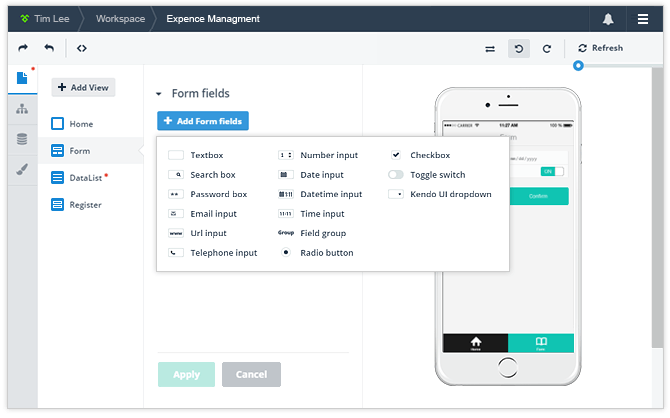
Screen Builder offers development teams two immediate opportunities:
It helps jumpstart apps by handling the basic app scaffolding and plumbing (creativing views, defining navigation, data binding), freeing developers to spend more time creating unique, app-specific views
It opens the door to engaging more “power user” stakeholders from the business earlier in the app dev process, so low- or no-code “developers” can help shape an app with their unique domain expertise
Screen Builder is available to all Telerik Platform customers, but for our enterprise customers, we are going further and unlocking Screen Builder extensibility.
Enterprise Extensibility in Screen Builder lets organizations customize and extend the toolbox of “views” exposed to their users of Telerik Platform. This enables IT organizations to create view templates that conform to enterprise standards, and it enables enterprise development teams encapsulate common patterns in quickly reusable components.
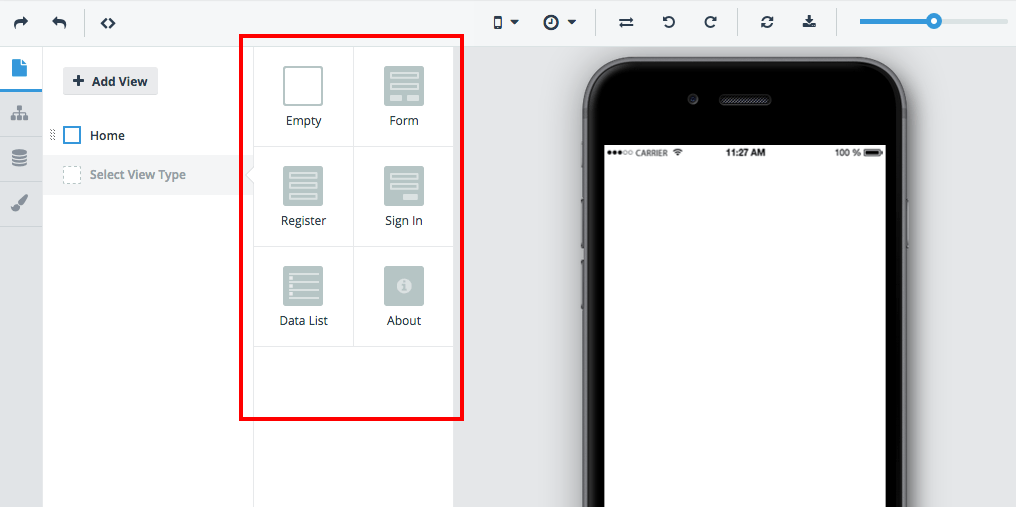
Under the covers, Screen Builder is built on the open source Yeoman generator, so creating new views will be simple for anyone that has worked with Yeoman. Enterprise Extensibility will be available to enterprise customers this summer.
In the future, we will make the 2-way workflow between AppBuilder and Screen Builder more robust, making it even easier to go back and forth between Screen Builder view configuration settings and customizations you make in code. We will also be extending the out-of-the-box Views toolbox with more pre-built views, and extended properties for existing views.
We have many exciting roadmap plans for Screen Builder, but we can’t wait to get your feedback as you start to use it in the real world--both in and out of the enterprise.
Support for Native (via NativeScript)
The Telerik Platform has always focused on helping developers avoid the “one-size-fits-all” approach to app development. Every app is unique, and as a result, to best balance costs and capabilities, some apps should be built for the web, some hybrid and some native. Most Telerik Platform modules have supported all forms of app development since launch. Things like Backend Services, Analytics, Testing and Feedback provide rich SDKs for web, hybrid and native app development.
The notable exception has been Telerik AppBuilder, where we’ve primarily supported hybrid (via Apache Cordova) development, and, recently, mobile web development, too.
With the launch of NativeScript, an open source framework created by Telerik for building native, cross-platform apps, Telerik Platform and AppBuilder now 100-percent support native app development, as well. You get all of the same benefits AppBuilder has always provided--cross-platform cloud builds, companion apps for rapid debugging, simulators, CLI, publishing wizards and more--but now for apps with native UI. Screen Builder also supports native app development with NativeScript.
Telerik Platform uniquely lets organizations focus on app requirements first, and then use the approach--web, hybrid or native--that best fits the project. And, because all approaches in Telerik Platform use JavaScript, there is 100-percent skill reuse between all of the major modes of app development.
AppManager LiveSync
Mobile apps reintroduced a problem the web originally helped us solve: delivering app updates to users fast. Web apps ushered in a new, post-desktop era of being able to ship quickly and often because updates could be easily deployed to users in real time. With mobile apps, the app update cycle took a step backwards, requiring updates to first be published to an app store (public or private) and THEN requiring the user to take action to update the app.
It’s hard to be responsive to the business’ needs when every update takes days to weeks to fully roll-out to users.
To solve that problem, we borrowed ideas from the popular AppBuilder LiveSync feature, which lets developers quickly see changes to an app as they are developing, and created AppManager LiveSync.
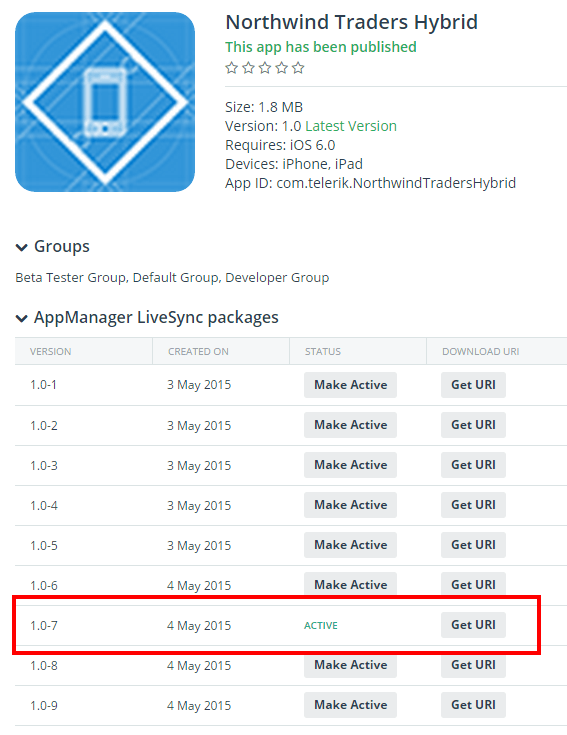
With AppManager LiveSync, development teams building apps with AppBuilder can push app updates to users immediately--in production--for apps deployed via public or private app stores. This works for BOTH hybrid and native apps (built with NativeScript).
When it’s time to publish an update to an app, developers can simply choose AppManager and push their update to users. The next time users open the app (which they must first install from an app store, of course), they will get an in-app notification that an update is available, and proceed with the update install. No app store update is required.
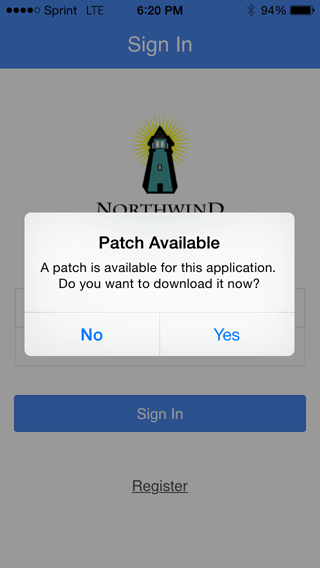
Better yet, updates can be easily rolled-back to previous versions, and in the near future, updates will be schedulable and segmentable to specific users. AppManager LiveSync a very cool feature that will help enterprise development organizations be even more responsive to the needs of the business, and less fearful of shipping fast and often on mobile.
Data Connectors powered by Progress DataDirect
Telerik Platform Backend Services have offered a limited set of “Data Connectors” for a while now. They let you connect existing, legacy data to your mobile apps via a secure, RESTful API automatically created by Telerik Platform. You simply install a DataLink Server near your original data source to create the secure link between Telerik Platform and your data, choose the objects you want to include in your API and then...BOOM...you have a ready-to-go, sercure RESTful API for your data (fully supporting CRUD operations, if you choose to).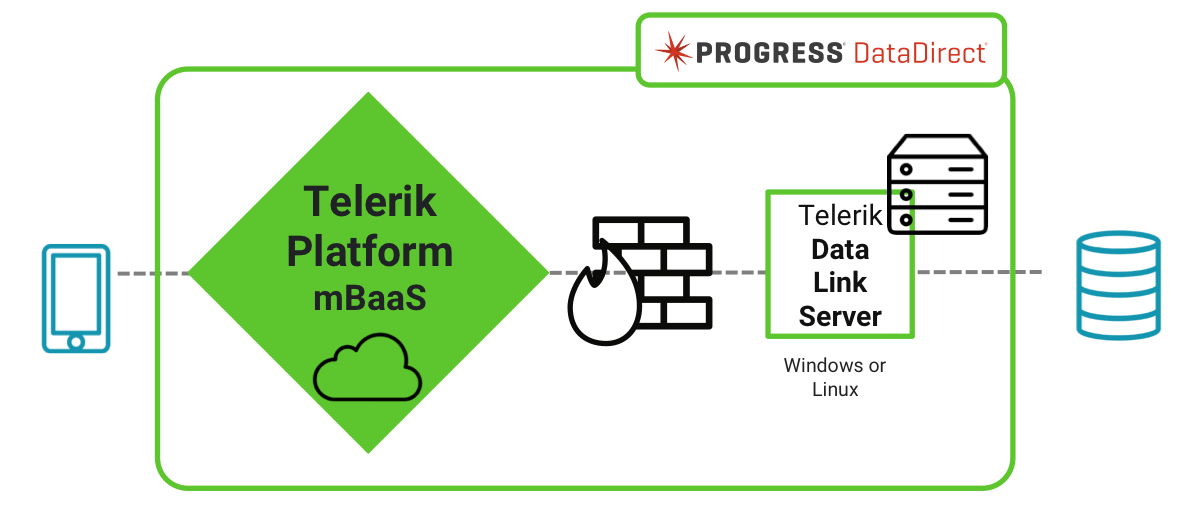
Until now, we’ve supported four basic data sources: SQL Server, Oracle, MySQL and PostgreSQL.
One of the advantages of being part of the Progress family is that we now have access to the rich portfolio of DataDirect technology. Progress DataDirect is a LONG-time leader in core data connectivity technology, and as it turns out, DataDirect had technology similar to Telerik Data Connectors, only much, MUCH more powerful and mature. It was a natural fit for Telerik Platform.
Data Connectors in Telerik Platform are now powered by DataDirect, which means two things:
DataLink servers are now Java-based, and can be installed on Windows or Linux servers near your data
Data Connectors can now connect to more than 20 different data sources

Initially, we’ll be supporting the original four data sources (SQL Server, Oracle, MySQL and PostgreSQL). Over the coming weeks and months, we’ll be lighting-up support for all of the data sources pictured above (and more), based on feedback from our enterprise customers.
Offline Data Support
Consistently, when we talked with app developers over the last year, the need for “offline” support in apps was flagged as a critical feature. And rightly so. Mobile apps are always on the go, and there is rarely a guarantee of an “always available” Internet connection (even within the walls of a WiFi office building). As a result, we wanted to make the challenge of building “offline” or “sometimes connected” mobile apps much simpler with Telerik Platform.
To do that, we’ve added Offline Mode support directly to the Telerik Backend Services SDKs. When enabled, offline mode stores app data locally and keeps track of changes when no Internet connection is available, then handles sync’ing the changes back to the server. It’s a client-side technology, so it’s simple to adopt, works with many different server-side data sources, and handles syncs for all but the highest-volume apps with shared edits. It’s also available in ALL Telerik Backend Service SDKs, meaning you can create offline-ready web(!), hybrid, native (including NativeScript) and Node.js apps.
Offline mode also provides out-of-the-box support for encrypting data at rest, and it exposes a rich API for programmatic handling of sync conflicts.
Adopting Telerik Backend Services with Offline Mode makes EVERY app faster, even if it doesn’t “expect” to be offline. There are two core advantages of using the offline SDKs:
Caching: Offline mode keeps a copy of recently used data so your app does not have to spend extra time re-fetching data, making your app feel faster to users (even when they are online)
Syncing: When an app is truly offline, and data changes are made, the Backend Services Offline SDK tracks those changes and attempts to sync/merge with a server data source when a connection is restored (using the configured sync scheme).
All Telerik Platform customers can use Offline Mode when working with Telerik cloud-based Backend Services data (based on MongoDB). Enterprise customers exclusively have the ability to use Offline Mode with other data stores via Data Connectors.
Streamlined Deployment Options
The cloud is MASSIVELY convenient for many organizations, but it’s not right for every organization. Whether it’s regulation or stringent security requirements or industry-specific datacenter certifications, the need to have Telerik Platform run outside of the cloud has long been recognized. We have supported various deployment options since mid-2014, but with this launch we’ve streamlined private installations of Telerik Platform.
Telerik Platform Enterprise Edition can now easily be installed on-premises (“OnPrem”) in your own private cloud, or even purchased as a managed private cloud service.
Private installations of Telerik Platform only require a hypervisor and a few simple virtual machines that Telerik provides. Exact configurations can vary depending on the features of Telerik Platform being used and the scale of an installation, but a core installation can be done in a day.
OnPrem installations can also be made highly available (HA) and integrated with existing back-up and restore procedures in your organization. Installations fully support scale-up and and scale-out expansion.
AppTemplate Marketplace
While features like Screen Builder and Data Connectors help you build apps quickly, they still require that you start from scratch assembling your app. From our conversations with enterprise customers over the last year, we know that many apps address common scenarios, and starting from a pre-built app template helps maximize project speed.
App templates acknowledge the fact that these common enterprise apps share 80 percent of their core concepts and logic, but need to be customizable to refine the last 20 percent to match company-specific vocabulary, processes and standards.
To make it easy to find (and publish) app templates that can be quickly consumed and customized in Telerik Platform, we are expanding our “Verified Plugins Marketplace” to now also support app templates.
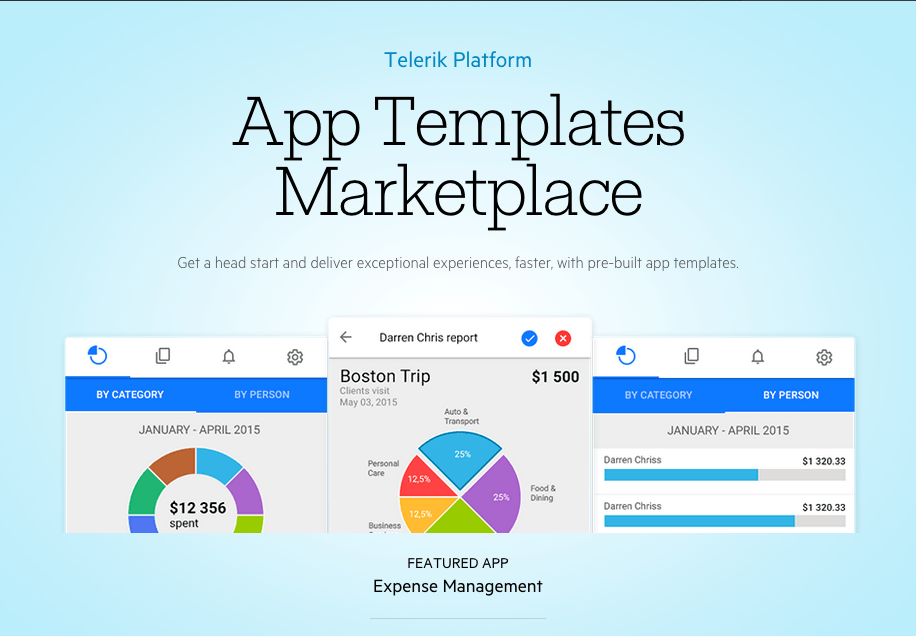
The new, expanded marketplace will be your one-stop for finding curated, high-quality plugins for Apache Cordova (hybrid) and Telerik NativeScript (native) apps, app templates and later this year, complete, ready-to-use apps.
One template you’ll soon find in the marketplace is an app built by Telerik called “Expensity.” Expensity is a simple HR expense reporting app built with NativeScript that can be fully customized and extended in Telerik Platform. If you need to build an expense reporting app, with this app template and Telerik Platform tools, you’ll be done before lunch.
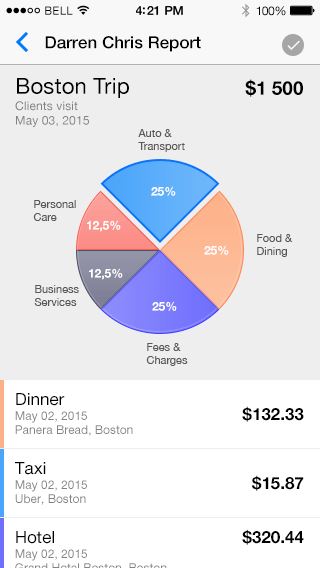
The Big (Platform) Picture
Clearly, there are LOTS of powerful new capabilities in Telerik Platform that will make all app development, but especially enterprise app development, faster, easier and more successful. These new capabilities build on the already rich foundation Telerik Platform provides for end-to-end app development, further extending our ability to help apps go from idea to deployment.
As you may recall, Telerik Platform addresses every step of the mobile app development lifecycle:
Design/Prototype
Develop/Debug
Connect/Integrate
Test
Deploy
Manage
Measure/Feedback
Tools such as Screen Builder and frameworks such as NativeScript bolster AppBuilder and Telerik Platform’s ability to help teams design, develop and debug every app, be it web, hybrid or native.
Enriched Data Connectors and support for Offline Data accelerate the process of connecting an app to data and integrating with existing systems of record.
The powerful Telerik mobile app testing will become even more interesting as Telerik Test Studio suite adds support for visual test recording and playback on iOS and Android later this year.
AppManager LiveSync ups the game for app deployment, making real-time app updates for hybrid or native apps possible, along with existing support for traditional private and public app store deployments.
And, last but certainly not least, Telerik Analytics and AppFeedback provide the deep insights teams need to learn from users and understand how apps are (or are not) being used in the real world, so future versions focus on the right improvements.
It’s comprehensive. It’s powerful. And it’s only possible with the combined strength of the hundreds of engineers at Telerik and Progress working to make software development better for the modern developer.
More to Come
As with all software, milestones are not destinations, but rather markers on the journey. We are excited to ship all of these enterprise-targeted improvements this month, but we have much more in the pipeline.
As modern app development evolves in the enterprise, Telerik Platform will similarly evolve with several key principles guiding our evolution:
Tools and services for every screen: Mobile kicked-off the modern app dev push, but aging websites and desktop apps, as well as new kinds of screens (think wearables) need modern tools to build for the future.
Data is the driver: Apps are ultimately front-ends to processes and data that live in systems of record. We want to make it increasingly easy to interact with that data--reliably and securely--in the apps you build.
Expand biz/dev collaboration: To unlock all of the knowledge that lives in the business, more people need to become empowered “app builders.” We want Telerik Platform to facilitate that interaction with tools that minimize the friction between power users and IT developers.
Want to learn even more? We are hosting an online launch of Telerik Platform Enterprise Edition on June 9. Come see new enterprise capabilities in action and learn more about the Telerik vision for helping modernize enterprise app development. We’ll also host a live Q&A session with a full panel of Telerik experts to answer your questions. Register now for June 9 webcast.
Enjoy the new features. And have fun building (enterprise) apps!

Todd Anglin
Todd Anglin is Vice President of Product at Progress. Todd is responsible for leading the teams at Progress focused on NativeScript, a modern cross-platform solution for building native mobile apps with JavaScript. Todd is an author and frequent speaker on web and mobile app development. Follow Todd @toddanglin for his latest writings and industry insights.
